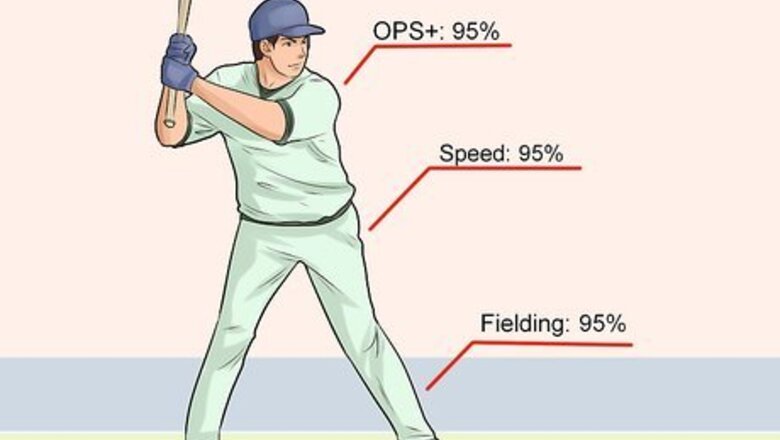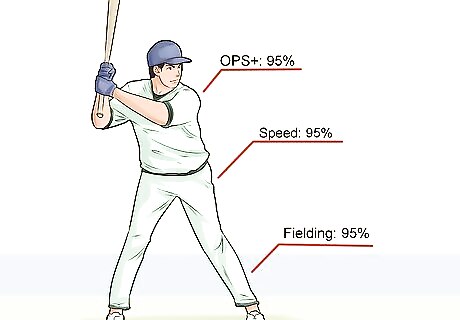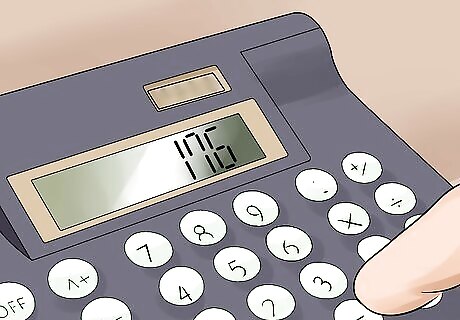
views
Rate a Position Player

Determine the WAR rating of position players against the league average in a variety of offensive, speed and fielding categories. These include: OPS+: Take the sum of the player's on-base percentage plus his slugging percentage, and compare the sum to the league average. The result yields a figure for batting runs above/below average. Ballpark and era adjustments: You must complete further detailed analysis to incorporate the characteristics of ballparks and style of play during the season you are analyzing. Do this by examining players' statistics at individual parks and comparing the figures to the league averages. These adjustments are extrapolated onto the player's batting runs figure for a final total. Speed: You can judge an individual player's speed against the league average by measuring several different categories. Stolen bases, caught stealing, ground ball double plays, and extra bases taken all factor into this figure. You will have to examine play-by-play records to determine a player's effectiveness in taking extra bases. Compare the player's statistics to the league average in the other categories. The results yield a figure above or below the league average that you add to the batting runs number. Fielding: Measure the player's defensive capabilities against the league average for putouts, assists and errors at his primary position. This produces a range figure. For infielders, add the range figure to the player's double-play number to arrive at a defensive number. Add the defensive number to the batting runs and speed numbers. Position adjustment: Some positions are more difficult to play than others. This is considered in WAR ratings. For example, shortstops get a +8 adjustment to their WAR. Right fielders are -8. For a complete list, search online for WAR position adjustments.

Find the replacement player's rating. To find the theoretical replacement player's rating, subtract 20 runs from the combined averages in the various categories.

Calculate the player's WAR rating. Compare the rating of the player and the replacement player. Divide the difference by 10 to find the WAR rating of the player.
Rate a Pitcher

Compile a pitcher's statistics in several categories and compare each to the league average. The key statistics for finding a pitcher's WAR rating are: Earned Run Average: Compare the pitcher's ERA to the league average. Defensive adjustment: Determine the defensive capabilities of the team that played behind the pitcher, compared to the rest of the league, and apply that figure to the pitcher's rating. This is done by comparing the fielding rating of each of the team's position players to the league average and applying that sum to the rating. Fielding Independent Pitching: F.I.P. is a tally of the 3 categories pitchers control entirely: strikeouts, walks and home runs. F.I.P., combined with average innings per start, yields a figure that represents the number of runs a pitcher must save to qualify for a win. Find the pitcher's F.I.P. and compare it to the league average. Pitcher's winning percentage above replacement: To find the pitcher's winning percentage, calculate the average number of innings per start. This number expresses how many runs the pitcher must save to qualify for a win. Subtract the league-average F.I.P. from the pitcher's F.I.P. and divide that result by the runs-saved number. This result will be expressed as a percentage. Add .500 to this figure to get the pitcher's winning percentage. Use a .380 winning percentage as the benchmark for comparison. Subtract the pitcher's winning percentage from this figure to get the result.

Find the pitcher's WAR rating. Take the pitcher's adjusted winning percentage above replacement and multiply it by the number of innings pitched. Divide that product by 9 to render a number that expresses how many wins the pitcher is worth.



















Comments
0 comment